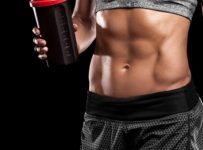by Charles Poliquin Iron Magazine
“Abs of steel” is one of the most popular expressions in the fitness industry. Everyone, from pro athletes to celebrities to weekend warriors, wants a six-pack. Problem is, most of what we hear about abdominal training is untrue. With so much misinformation circulating, it can be difficult to separate fact from fiction. Here’s what we do know.
The fact is, just about anyone can develop tremendous abdominals without ever performing a sit-up, crunch or anything involving fancy circus balls or other gimmicks. Core training doesn’t have to be complex training.
As evidenced by the muscular midsections of powerlifters and weightlifters, simply performing total-body lifts such as squats, power cleans and deadlifts can develop impressive abdominals. Peer-reviewed research supports this real-world evidence.
A study published in Physical Therapy in Sport in 2011 found that competitive female weightlifters, a group whose training focuses on low reps with heavy weights, had significantly stronger internal and external oblique muscles than a recreationally active control group. More specifically, in the weightlifting group the internal obliques were the thickest, followed by external obliques, and then by transverse abdominis. This is a significant finding, as it represents a “structurally balanced” relationship that is optimal for athletic performance and spinal health.
As for the Swiss ball crunch, it’s important to be aware of the risks of performing this popular exercise. It works the rectus abdominis through an extreme range of motion; unfortunately, an overemphasis on this exercise could cause lower back pain and create a muscle imbalance that may increase the risk of abdominal injuries and hernias (perhaps this is why we are hearing the term “sports hernia” more frequently?). Further, and this is true for athletes who display an excessive forward tilt of the pelvis (i.e., lower cross syndrome), performing Swiss ball crunches could create shearing forces on the spine that could injure the disks. As for regular crunches, after a few sessions the exercise often becomes too easy to produce any strength training effects.
Although specific abdominal training is unnecessary for most trainees, if you want some extra “ABsurance” for great abs, there is usually little harm in supplementing your training with an occasional phase of abdominal training. For those of you who decide to go this route (and are following the appropriate nutritional path to stay lean so you can actually see your abs), here are a few suggestions besides traditional crunch exercises.
One exercise you might consider is the single-leg jackknife sit-up (known for its popularity among Russian sprinters because it works the hip flexors and rectus abdominis in a coordinated manner such as occurs in running). In contrast to the classic jackknife sit-up, with this variation one leg is bent and the entire foot is in contact with the floor, with the other leg straight. With your arms held at your sides (or overhead and brought forward), lift your leg and trunk simultaneously as rapidly as possible. Perform an equal number of reps for each side, and increase resistance with the use of wrist and ankle weights.
Another exercise is the reverse sit-up, with legs bent and with legs straight. In the early 1970s Dr. John Garhammer wrote an article for a weightlifting magazine in which he discussed a version of the reverse sit-up – with the ankles crossed – which he learned from Dr. Richard Herrick. Turning the feet inward has been shown to increase the electrical activity of the rectus abdominis at the expense of the hip flexors. What’s interesting is that because Dr. Garhammer wrote the article, bodybuilding writers started calling the exercise the “Garhammer raise,” and the name stuck.
With the Garhammer raise, you start with your legs crossed and then lift your hips straight up, pulling your knees towards your chest. The beginner version of this exercise would be performed on the floor, followed by an incline bench and then hanging from a chin-up bar (or from a dip stand or vertical sit-up station). Although this exercise activates the entire area of the rectus abdominis, it also strongly works the subumbilical (below the bellybutton) area of the abdominals.
In the weightroom, two great ab exercises are pullovers and straight-arm lat pulldowns. Although just about any pullover will affect the abs, you can perform a particularly effective variation by anchoring your feet on a sit-up board with your knees bent; pull the weight behind your head and then return to the start. The key is to keep your trunk stationary – you can make the exercise harder by leaning backward and holding heavier objects. As for straight-arm lat pulldowns performed on a high-pulley machine, the late biomechanist Dr. Mel Siff claimed that this exercise works the rectus abdominis muscle more strongly than sit-ups do! All front lever types of exercises, whether on rings or high bars, are also superb for that purpose.
The bottom line is that if you want abs of steel, you need to pump the iron! However, for those who feel they need a bit more to get that enviable six-pack, try hardcore exercises you can occasionally add to your exercise mix.
Source: http://www.ironmagazine.com/2014/red…your-six-pack/






